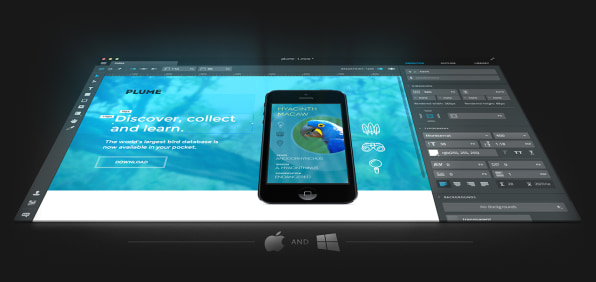Mac Os X Dictionary.app Download
Twenty years out of appointment and kludgy, current design tools like Photoshop and Illustrator force designers to create mockups manually. Frustrated by what they felt was an Adobe design monopoly, the creators of Macaw set out to build a totally new kind of design tool.
Only when technical challenges popped upwards, it was an open source projection from Adobe itself that saved them–and convinced them that their technology was headed in the right direction.

"We were but a couple of guys who were sick of the fashion the industry was being run by some of the big companies," says CEO Tom Giannattasio. "It definitely feels like nosotros were revolting against the options we had."
"Hybrid" Desktop Apps Use WebViews, Just Similar Some Mobile Apps
Historically, in that location have been two ways to build an app. The first is to create a native app that runs locally on a device–the best choice when performance and native features (similar offline mode) are required. The 2nd is to create a web app using HTML, CSS, and JavaScript that lives entirely online, usually a better selection when the app needs to piece of work across multiple platforms or devices.
However, at that place is a third choice. Building a hybrid app–a native app shell that contains a web app, hosted somewhere else–has been common on iOS for years. If it'south built right, a hybrid app tin be fast, smooth, and work cross-platform. The best of all worlds.
"We actually started as a web app then that it would live within of a normal consumer browser–you lot would log in, work, configure files on a server somewhere," says Giannattasio. "And we started realizing that normal consumer browsers have a lot of restrictions, and don't make for the best user experience for people. We were building a tool for pros, so we thought feel of the utmost importance that information technology be fast and streamlined for those users."

The team decided to build a native Bone 10 app, with a UI component chosen UIWebView displaying the spider web app they had built. The goal: Go some of the added operation of native software, simply even so have the flexibility of building a web app hosted somewhere else. But issues popped up right abroad.
"We started running into problems because Apple tree throttles performance that you become within of those WebViews. Information technology was just killing our performance. This was probably the biggest hurdle that we hit. And we were similar 'Well shit, what do we do?' We know it needs to be native but we can't become the performance we need," says Giannattasio.
Talking To Adobe, They Discover The Brackets-Shell Framework
How did they find their solution? Ironically, it was from the company were rebelling against.
"We were so frustrated one night that we left, and I went and had drinks with a production managing director from Adobe. He was asking what we're built on. I told him, and he's similar 'We've got this framework that's open source.' And I was like… I did not know that. We literally went in the next day and completely transitioned the app onto this new framework. Now nosotros can suck all the performance that we need out of it and we can start really customizing it. It'due south funny right? Because I think our biggest competitors are Adobe, number one, and Google is number two because they entered the infinite besides," Giannattasio explains. "Nosotros are congenital on both Google and Adobe's frameworks: chromium embedded framework. It's Chrome, just stripped down. And that's open up source. Adobe took that, repurposed it for the big congenital apps in the same way that we wanted to, and they open sourced that. It'southward called brackets-shell."
This speaks to the weird nature of open up source, where bullies are also the benefactors. It besides points to a shift happening in business–from competition to coopetition.
"Everyone is helping everyone else. Especially all the small-scale players. We all know each other," Giannattasio explains. "That'due south something about our industry; information technology'southward very community-based and we're all very friendly. These are but problems that we feel Adobe hasn't addressed properly."
Why Are Hybrid Apps On The Ascent?
"These hybrid apps–I remember people are going to offset seeing a lot more of them," says Giannattasio. "A lot of mobile apps have started to move in that direction and desktop apps are starting to do that likewise. I did a lot of piece of work with Apple before starting Macaw and a lot of their cadre applications are basically merely HTML based. I don't recall a lot of people know that."
Having a hybrid helps work around some of the cons of having a native app that just lives on the calculator. App updates don't need to be downloaded by users, since developers can change the app on the backend. And teams don't accept to take a programmer who specializes in each different platform to create the app (since most development is done with spider web technologies which are cross-platform). It is a little similar Java's tagline "write one time, run anywhere," except it actually (mostly) delivers on the promise.
In add-on, as i designer friend mentioned to me, there is a psychological legitimacy to native/hybrid over web. No serious designer is going to open Chrome to pattern something. Information technology simply doesn't feel like a product unless information technology has an icon in your dock.
And as Giannattasio points out, more developers can build this way. Since hybrid sites are fabricated with standard web technologies, even people with bones dev skills tin can manage. "HTML continues to abound really apace, and and then the possibilities are only growing and growing. People with normal web dev skills tin showtime to build really really advanced applications," he says.
Why Old Tools Don't See Modern Pattern Needs
So why does Macaw crave a native trounce to run? Its because information technology has twin engines that require a lot of processing ability: a layout engine and a pattern-to-code engine called Abracadabra.
"The start layout engine was very similar to Photoshop's layout engine. Information technology used accented coordinates," he says. "But we quickly realized that that makes no sense when it comes to the web, and it wasn't sufficient for a web designer's needs. So we moved toward a existent-time layout engine that calculated the margins, floats, clears and all the necessary layout logic for y'all on the fly."
People refer to this type of tool as "The Holy Grail" because it's blueprint tool that knows how to code, says Giannattasio. "Basically what we're doing is we're hunting down all these relationships in the document in the same fashion that a developer would. We're doing is finding relationships between elements and automating that."
Macaw is the newest, but not the the only player in the space. Both froont and Bohemian Coding'southward Sketch app are similar tools–and they have had more fourth dimension to improve on them. All these tools are working toward the same stop: conflating design with evolution, so that designers can create apps without writing much code.
"It'due south really of import that we automate the coding procedure, and implement all-time practices because, Why not?" Giannattasio argues. "Why should nosotros have to sit down there and write out all this stuff when lxxx-xc% of it is the aforementioned stuff that we write for every other project? If Macaw understands enough of those best practices, why tin can't it just practice that for the states?'"
Mac Os X Dictionary.app Download
Posted by: johnnystearle59.blogspot.com
Post a Comment